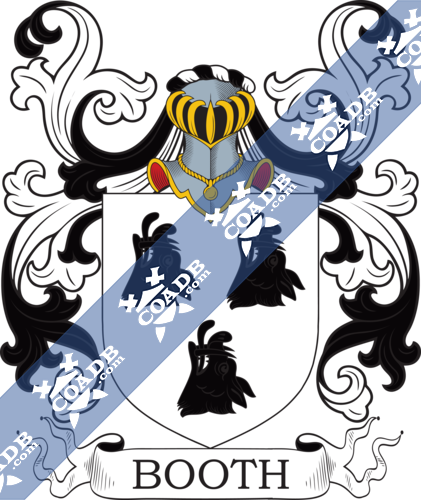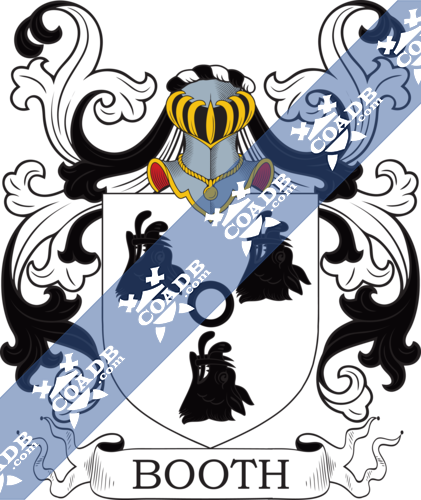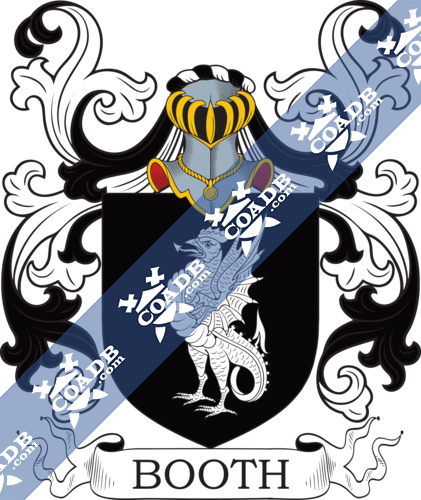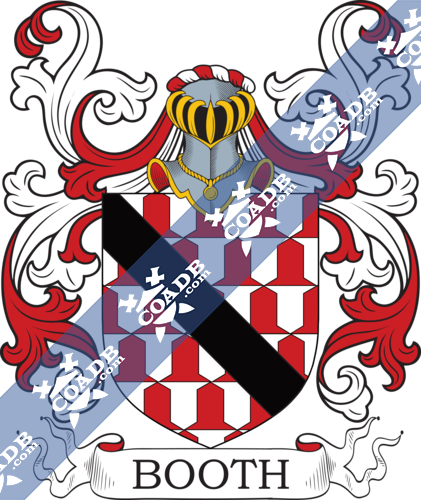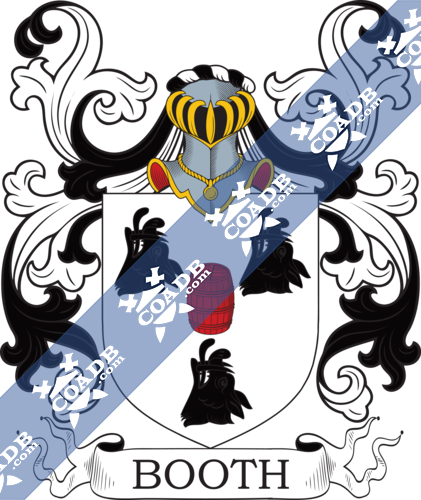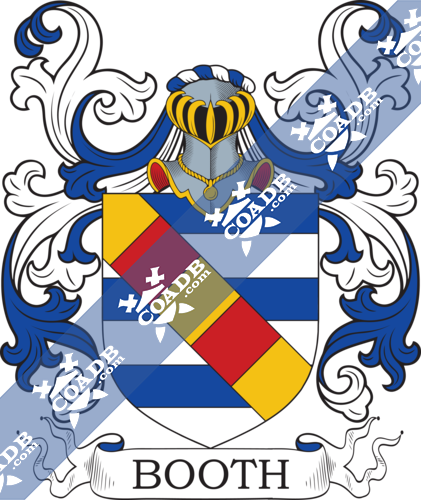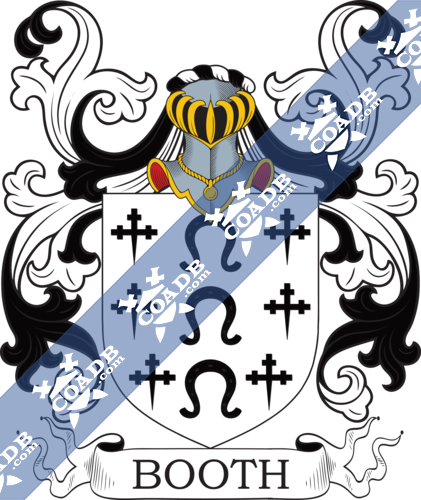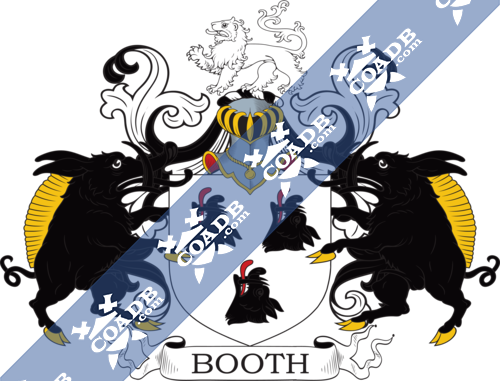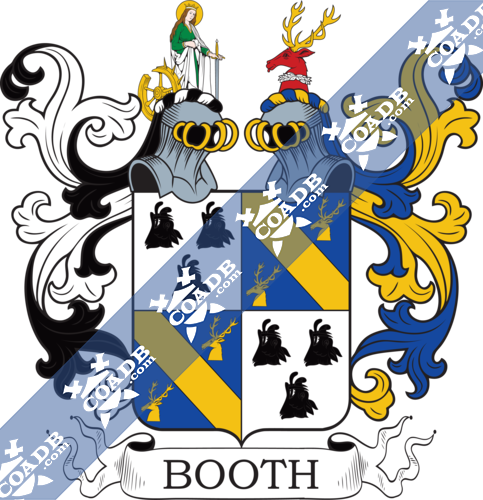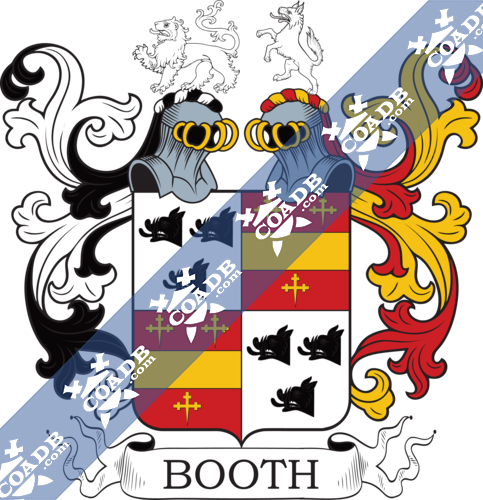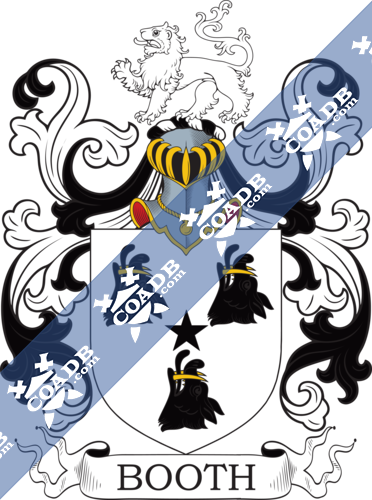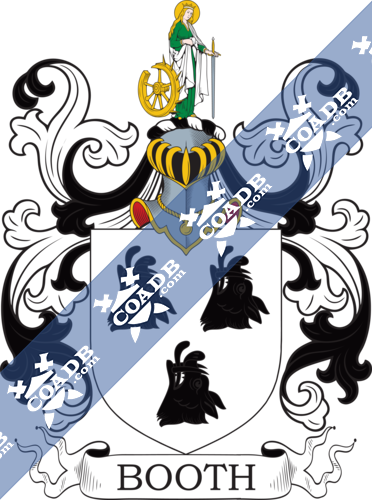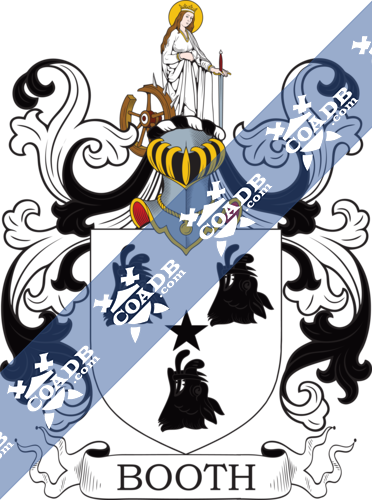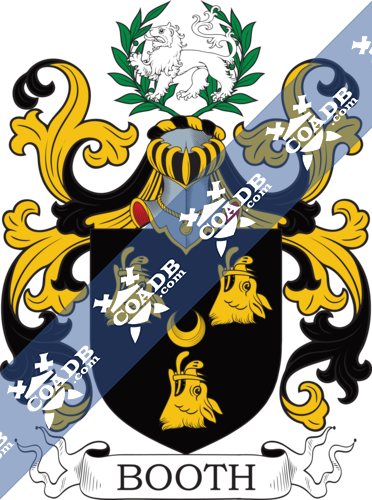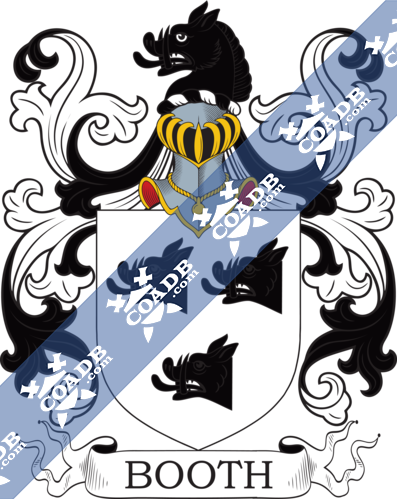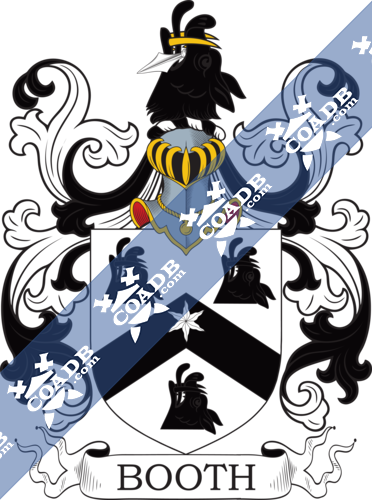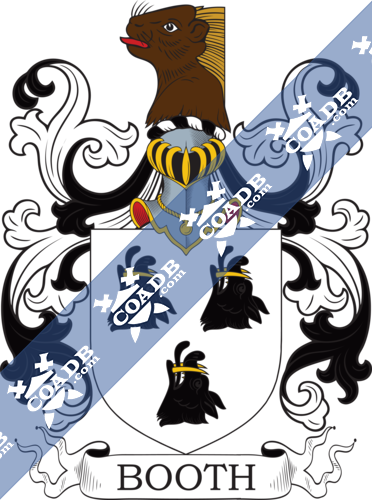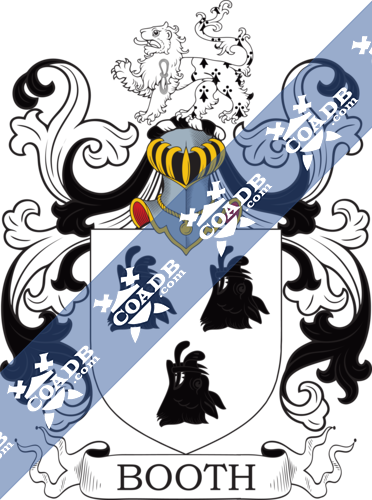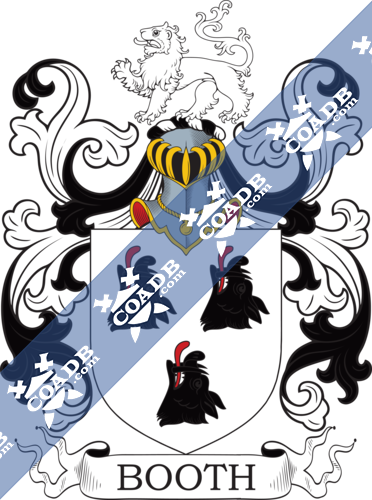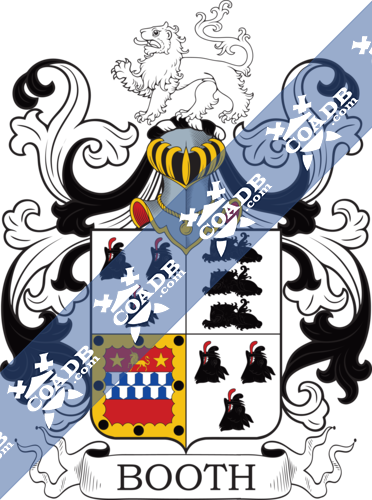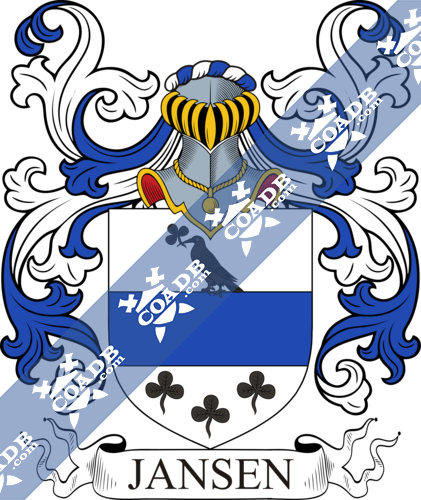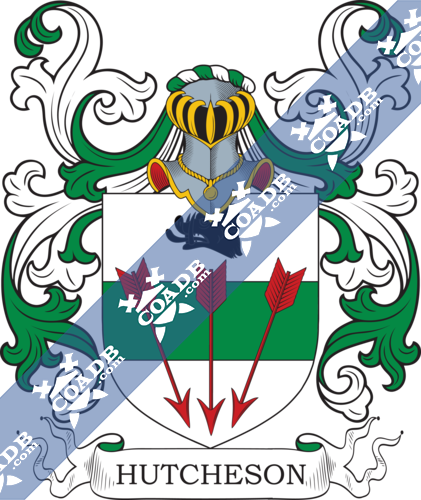Booth Family Crest, Coat of Arms and Name History

Booth Coat of Arms Gallery
Don’t know which Coat of Arms is yours?
We can do a genealogical research. Find out the exact history of your family!
Learn MoreBooth Surname Name Meaning, Origin, History, & Etymology
This primarily English and Scottish (or Anglo-Scandinavian or Anglo-Saxon) is a locational or habitational or topographic last name meaning “at the booth”, with booth referring to a small barn, cottage or hut, derived from the Middle English word bothe (which in turn derives from the Old Danish word both and the Old Norse word buð), denoting a person that came from or lived in such a facility or structure, primarily shepherds and cowmen who dwelled on summer pastures. Mark Anthony Lower’s nineteenth century work, Patronymica Britannica, states the name derives or means “a house made of bowes”, referring to a temporary shed or building, deriving from the Low Latin word botha. It may also derive from the Scandinavian, Norse, or Viking personal (first) name Boði, Bud, Bueth or Boothby. Erin Rosenthal’s 1965 book, South African Surnames, states this is Old Danish for “Herdman’s Hut”. Samuel Lewis’ 1848 book, A Topographical Dictionary of England, states the following in regard to this surname: “Barton Old Hall, a brick edifice, now a farmhouse, was the seat successively of the Barton, Booth, and Leigh families”.
In relatively modern times, the family is notable for two reasons. First, according to Wikipedia, “The Booth family was an American theatrical family of the 19th century. Its most famous and well-known members were Edwin Booth, one of the leading actors of his day, and John Wilkes Booth, who assassinated Abraham Lincoln. The patriarch was Junius Brutus Booth, Sr., a London-born lawyer’s son who eventually became an actor after he attended a production of Othello at the Covent Garden theatre”. Second, another branch of the family was heavily involved of the founding and operating of the famous humanitarian/charitable organization known as the Salvation Army. The website SalvationArmyUSA.org states the following: “Soon after beginning his ministerial career in England in 1852, William Booth abandoned the concept of the traditional church pulpit in favor of taking the gospel of Jesus Christ directly to the people. Walking the streets of London, he preached to the poor, the homeless, the hungry, and the destitute. When fellow clergymen disagreed with Booth’s unconventional approach, he and his wife Catherine withdrew from the church to train evangelists throughout England. The couple returned to the East End of London in 1865, where many followers joined their fight for the souls of lost men and women. Within 10 years, their organization, operating under the name “The Christian Mission,” had over 1,000 volunteers and evangelists”.
Spelling Variations
Some spelling variants or names with similar etymologies include Both, Boothe, Boothy, Bootha, Bootho, Bootho, Boothey, and several others. In the Hundred Rolls, the name was spelled or recorded as De la Boothe. Many early bearers of this surname spelled it de Booth or de Boothe.
Popularity & Geographic Distribution
The last name Booth ranks 604th in popularity in the United Status as of the 2000 Census. The name ranks particularly high in the following four states: Alaska, Wyoming, West Virginia, and Virginia. The surname Booth frequency/commonness ranks as follows in the British Isles: England (158th), Scotland (353rd), Wales (293rd), Ireland (1,266th) and Northern Ireland (618th). In England, it ranks highest in counties Cheshire, Derbyshire, Lancashire, and Yorkshire. In Scotland, the surname ranks highest in county Aberdeenshire. In Wales, it ranks highest in Denbighshire. In Ireland, it ranks highest in county Wicklow. In Northern Ireland, it ranks highest in county Fermanagh. The name is also present throughout the remainder English speaking world: Canada (1,033rd), New Zealand (189th), Australia (250th), and South Africa (1,033rd). Henry Brougham Guppy’s 1890 book Homes of Family Names in Great Britain states the following in regard to this last name: “The Booths, of whom there are many distinct and ancient families, those of Dunham, Mollington, Mottram, Twemlow, etc., have played a great part in the history of the county (O.). The name is also numerous in Derbyshire, Staffordshire, and the West Riding” and “The Booths of Derbyshire, who have their homes in the Derby district and in the north – western comer of the county, take their name from hamlets in the shire”.
Early Bearers of the Surname
The Poll Tax of Yorkshire in 1379 AD lists three bearers of this last name: Rogerus de Bothe, Adam del Bothe, and Margeria del Bothe. Hamnet Booth of Mouldsworth, a husbandman, was recorded in the Wills at Chester in 1593. The History of Norfolk documents one Odo de le Boothe was the bailiff of Norwich in 1291 AD. The Court Rolls of the Manor of Wakefield records one Gilbert del Both in 1297 AD. William Booth, who lived from 1390 to 1464, born in Barton, Lancashire, was the Archbishop of York. Baine’s Lancashire lists the will of one Thomas del Booth in 1368 who lived in Barton, near Manchester, England. An early marriage involving this surname was Dionise Boothe in Thomas Lawrence in London, England in 1548. Another was George Booth to Mary Silver at St. Mary Aldermary in 1716.
The name was also present in Scotland. George Fraser Black’s 1946 book, The Surnames of Scotland, states the following in regard to this surname: “The ship of Walter de La Bothe, merchant of Aberdene, was plundered at sea by the English near Yarmouth in 1273 and Cristiane ‘atte bothe’ of Berewyk rendered homage in 1296” and “Andreas de Botha witnessed a Glassarie charter in Dundee in 1321” and “Nicholas de Botha was proprietor of a land in Dundee in 1381”.
Booth Family Tree & Booth Genealogy
Booth of Glendon Hall
The lineage of this family traces back to John Booth of London, England (present day United Kingdom, also formerly known as Great Britain) who was seated at Cheshunt, Hertfordshire. He died in 1733 and with his wife Anne (daughter of William Lloyd of Liverpool), had several daughters and four sons with her, the sons being named John, William, Montagu, and Benjamin. John, the eldest son, was an Esquire of Theobalds, county Hertsfordshire and also of Glendon in county Northampton, England who was born in May of 1721. He married Phoebe Wilkinson of London, and heiress, with whom he had several children. His fourth son, Robert Booth, of Huntingdon and Alconbury Hill, was born around 1758. He married Mrs. Maule of Huntingdon and died in 1798, leaving a daughter named Phoebe and a son named Robert. Robert was born in 1794 and he married Miss Edwards, daughter of Reverend Mr. Edwards, with whom he had eight children. He died in 1782 and was succeeded by his eldest son. This eldest son was Richard Booth, an Esquire of Glendon Hall, county Northampton, who was born in 1756, and was also a High Sheriff. He married Janet, daughter of Sir Gillies Payne of Tempsford, Baronet, and had issue with her as follows: John (his heir discussed below), Richard (born 1799), George Neville, Janet (married Reverend Henry Rule Sorel, Rector of Balcombe Sussex), Anne, Laetitia Mary, Caroline Matilda (married Richard Palmer of the Palmers of Grantham), and Elizabeth Purefoy. He died in 1807 and was succeeded by his eldest son John. This John was an Esquire of Glendon Hall, England, a High Sheriff, and Deputy Lieutenant, who was born in March of 1794. In 1835, he married Augusta de Capell-Brooke, daughter of Sir Richard Brooke de Capell-Brooke, of Oakley House, county Northampton, Baronet, and had issue with her, including a son named Richard. This Richard Booth was an Esquire of Glendon Hall, county Northampton and Justice of the Peace who was born in 1836. In 1860, he married Margaret Home, the daughter of John Gibson Reeves of Moseley, and had seven children with her as follows: Robert Home Brook (1862), Arthur Payne (1863), Richard Jasper (1866), Beatrice Augusta de Capell, Margaret Agnes, Mildred Janet, and Phyllis Helen. The Booth Coat of Arms (mistakenly called the Booth Family Crest or Booth Family Shield) is blazoned in heraldry as follows: Argent, three boars’ heads erected and erased sable. Crest: A lion passant argent. Motto: Quod cro, spero. The family seat was at Glendon Hall, Kettering, county Northampton.
Baronet Booth
The Booth genealogy of this branch of the family tree traces back to Thomas Booth of Toxteth Lodge, Liverpool, who was born at Orford, near Wattington, England in 1749. In 1784, he married Esther, daughter of James Noble of Lancaster, and had issue with her, including the following: Henry (a corn merchant at Liverpool and railway projector), James (Counsel to the Speaker of the House of Commons in 1839, and Secretary of the Board of Trade 1856-65, born 1796), and Charles. He died in 1832 and was succeeded by his eldest son, Charles Booth of Liverpool, was born in 1799. In 1829, he married Emily, daughter of Thomas Fletcher of Liverpool, and had issue with her including the following: Alfred, Right Honorable Charles (married Mary, held numerous positions including President of the Royal Statistics Society, daughter of Zachary Macaulay, had issue named Thomas Macaulay, George Macaulay, Charles and Zachary Macaulay), Antonia Mary (married Sir Malcom Martin MacNaghten, son of Baron Macnaghten and had issue with him), Paulina Mary (died young), Margaret Paulina (in 1906, married William Thackeray Denis Ritchie, son of Sir Richmond Thackeray Ritchie, had issue), and Mary Imogen (in 1912, married Colonel Eric Gore Browne, had issue named Anna and Hester Emily). This Charles died in 1860 and was succeeded by his eldest son Alfred. This Alfred Boorth, who lived on Ullet Road in Liverpool, England (modern day United Kingdom, once Great Britain) was a Justice of the Peace who was born in September of 1834. In 1867, he married Lydia Ailen, daughter of Benjamin Franklin Butler of New York (Attorney General of the United States) and had issue with her as follows: Honorable Captain Charles of the Royal Navy (held numerous positions such as Director of London, Midland, and Scottish Railyway Company, born in 1868, in 1895, married Grace Bryson, daughter of John Weils of New Jersey, had issue named Henry, Lieutenant Commander John Weils, Alfred, Charles, Thomas Lawrence, and Lydia Grace), Sir Alfred Allen (created a Baronet), Mabel, Hester Emily (married Alfred Hughes, a professor at Birmingham University), Constance Lydia Ailen (in 1904, married Godfrey Isaac Howard Lloyd of Old Pount Cottage, Chombham, Surrey, England, a professor at Toronto University in Canada, had children with him), and Harriet Anna (of The Gret House, Boars Hill, Oxford, England, in 1909, married Arthur Gregory Whitting). His son Sir Alfred Allen Booth, 1st Baronet, of Allerton Beeches, Liverpool, England was born in 1872. He was a Director Alfred Booth and Company and educated at Harrow and King’s College Cambridge. He was created a Baronet in January of 1916. In 1903, he married Mary Blake, daughter of Edmund Dwight of New York and Mary Flanagan (daughter of Commodore Homer Crane Blake of the United States Navy), and had three issue with her as follows: Philip (born 1907, in 1935 married Steila Fenton Wood, daughter of I.J. Gerr of Vredefort, South Africa, and New York), Edmund (of Hardwicke House, Ham Common, Surrey, born in 1908, in 1933 married Henrietta Mary, daughter of Sir Charles Addis, had issue named Anthony Edmund, Martin Butler, Philip Addis, and Mary Rachel), and Sylvia Emily (in 1907, married Ivan Amis, son of Henry, of Thornton Way). He later (in 1925) married Margaret Lucy, daughter of Charles Edward Brightwen of Scarborough. The Booth Coat of Arms (sometimes incorrectly called the Booth Family Crest or Booth Family Shield) is blazoned as follows in the medieval European art of heraldry for this branch of the Booth family tree: Per pale per chevron argent ermine and sable in chief two boars’ heads erased and erect of the last and in base a like boar’s head of the first. Crest: A rose gules, barbed, seeded, and encircled by two olive branches proper, thereon a lion passant argent. Motto: Nec temere nec timide. This family resided at Barton Hatch, Limpsfield, county Surrey, England (modern day United Kingdom, once called Great Britain) in the British Isles of Europe.
Other Booth Pedigree & Family Trees
The progenitor or paternal ancestor of this family was Adam de Booth, who was born in Barton, Lancashire, England around 1200 AD. He himself descended from a noble Norman family from France who came to England with William the Conqueror during the Norman Invasion of 1066 AD. He married and had a son named William. This William was born in Barton, Lancashire, England around 1222 AD and he married Sybil Brereton and had a son with her named Thomas. This Thomas Booth was born in Barton, England in 1245 and he had a son named John. John was born in Lancashire, England around 1263 AD. He married Loretta Barton and had issue with her as follows: Ann, Henry, Katherine, Margaret, William, Robert, Mary, Thomas, and John. His son Robert del Booth was born in England around 1285 AD. He married a woman named Agnes and had a son with her named Thomas. This Sir Thomas del Booth was born in Preston, Lancashire, England around 1320 AD. He married Elena Worsley and had three children with her as follows: John, Elizabeth, and Alice (Leigh). His son Sir John was born in England around 1354. He married Joanna Trafford and fathered the following children with her: Thomas, Margaret (Byron), Joan (Southworth), Robert, William, Lawrence, Roger, and Alice (Clifton). In 1404, Thomas de Barton allowed John de Bothe and his heirs to bear his arms: three boars heads sable. These can be found on the Bothe family tombs contained in Sawley All Saints Church. His son Sir Robert Booth or Boothe was born in Barton, Preston, Lancashire about 1390 AD. He married Dulcie Venables and had the following issue with her: Robert, Ellen (Legh), William, and Alice. His son Sir William was born in Barton, Eccles, Lancashire, England around 1420 AD. He married Maud Dutton and was the father of numerous children: Douce (Legh), Anne, George (Dunham), Ellen, Lawrence (or Ralph?), Richard, John, Margery (Hyde), Sir Phillip, William, Isabell, Catherine, Alice, Elizabeth, and Joanse. His son George Booth was born in Barton, Eccles, Lancashire in 1445 AD. He married Katharine (Montfort) Ferror and had the following issue with her: William, Lawrence, Roger, Alice Anne, and Ellen. His son Sir William Booth was born in Dunham-Massie & Bollin, Cheshire in 1473 AD. He married twice: Margaret Ashton and Ellen Montgomery. He had the following issue: George, John, Edward, William, Agnes (Corbet), Margaret, Hammet, Henry, Andrew, Anne, Jane, and Dorothy. His son Geroge, Esquire, was born in Dunham Massey, England around 1490 AD. He married Elizabeth Boteler and had children with her as follows: Anne (Massey), George, Ellen (Carrington), Elizabeth (Locke), Dorothy (Tatton), and Margaret (Davenport). His son George Booth, Esq. was born in Dunham, Cheshire in 1515. He married Elizabeth Trafford and four children with her as follows: Elizabeth, Mary (Davenport), Anne, and William. His son William was born in Dunham, England in 1540. He married Elizabeth Warburton and had issue with her as follows: George, John, William, Eleanor, Peter, Susan (Warren), Richard Sr., Dorothy, Edmund, and Alice (Ford). His son Sir George Booth, the 1st Baronet of Booth of Dunham Massey, was born in Cheshire, England in 1566 AD. He married twice: Jane Carrington and Katherine Anderson. He had eight children: Elizabeth, Alice (married Sir George Vernon), Susan, William, Francis, Thomas, Edmund, and Sir John. His son Sir John Booth was born in Woodford, Cheshire in 1602. He married Dorothy Saint John and had issue with her named Thomas, William, St. John, and John. His son John Booth Sr. was born in England in 1637 and he went to colonial America where he married Elizabeth Granger in Pembroke, Plymouth, Massachusetts in 1656. He was the father of the following children: Elizabeth, Joseph, John Jr., Benjamin, Mary (Barden), Abraham, Grace (Pray), and Judith (Peirce). His son Benjamin was born in Scituate, Plymouth, Massachusetts in 1667. He married twice: Mary Sutton and Hannah Stoughton. He had the following children: Hannah (Braley), Benjamin Jr., John, Isaiah, and Anthony. His son Benjamin Booth Jr. was born in the same town in Massachusetts in 1698. He married Sarah Hoskins and had a son with her named Joseph Sr. This Joseph Booth Sr. was born in Plymouth County, Massachusetts in 1734. He married Sarah Haskins and had a son with her named Joseph Jr. This Joseph Jr. was born in Middleboro, MA in 1756. He married Betsy Cely Smith and had numerous children with her as follows: Sergeant, Guilford, Josiah, Betsey, Sarah, William, Amasa, Mercy, James S., Smith, and Priscilla. His son William was born in Plymouth, Massachusetts in 1785. He married Sarah Ashley and had a son with her named Lyman. This Lyman Booth was born in New York in 1821. He married Alice Melvina Bushnell and had a daughter with her named Lucy J. Booth. Lucy was born in New York in 1845. She married Edwin Wallace Rose. Prior to her 1930 death in Iowa, she had a daughter named Sarah Eleanor (Rose) Sherat.
The website boothancestry.wordpress.com, states the following: “It has been suggested by some that Adam was involved in the Norman Invasion of England with the forces of William The Conqueror in 1066, However recorded history and research has not shown any evidence of this, and it is very unlikely as the 1066 Invasion was a good 100 years before Adam’s Birth. The Domesday records also show no land ownership or title held by a Booth in the 11th century. This is not very surprising as nearly all the land under the administration of William the Conqueror (King William I) at this time had been given to the extremely powerful Norman Lords who were either directly related to William the Conqueror or were part of the 15 companion Knights at the Battle Of Hastings. However it is very possible that a Booth ancestor who went by a Christian name only, which was not uncommon in the time, was perhaps a warrior knight in the service of a more Noble Norman Lord in the armies at various stages of the Invasion and not just the Battle of Hastings”.
Here is another pedigree or lineage of this family:
Sir William Booth (born in Dunham, Massey, England in 1540, son of George)
Richard Booth Sr. (born in Great Rudwort, Cheshire, England in 1578)
Richard Thomas Booth (born in Great Budworth, England in 1607, went to Straford, Connecticut)
Joseph Booth Sr. (born in Stratford, Connecticut in 1656)
Dr. Joseph “Deacon” Booth Jr. (born in Stratford, Fairfield, Connecticut in 1689)
Stephen Booth Sr. (Stratford, Fairfield, CT in 1721)
George H. Booth Sr. (born in Stratford, Connecticut in 1737)
Isaac Abner Booth Sr. (born in Montgomery, Virginia in 1758)
Isaac Abner Booth Sr. (born in Rye, New York in 1787)
James Booth (born in Montgomery, Virginia around 1820). He married Catherine Jane Lester and had the following issue with her Isaac, John, Mary A., Nancy A., James H., Hulin A., Isabella, Charles G., Giles H., and Jacob N.
Early American and New World Settlers
The book Genealogical Guide to the Early Settlers, mentions one bearer of this last name:
1) John Booth of Sciuate, Massachusetts, in 1656, had issue named Joseph (1659), John Benjamin, Abraham (1671), Eliza, Mary, Grace, and Judith.
2) Michael Booth of Roxbury, Massachusetts, had a daughter named Martha born in 1688.
3) Richard Booth of Stratford, Connecticut, 1640, who married a sister of Joseph Hawley, and had issue with her named Elizabeth (1641), Ann, Ephraim (1648), Ebenezer, John, Joseph (1656), Bertha, and Joanna. He was a selectman in 1669 and was 80 years old in 1687.
4) Robert Booth of Exeter, 1645, moved to the town of Saco in 1653, where he was a representative from 1659. He died in 1692 at the age of 68. He was also a preacher. He married a woman named Deborah and had issue with her as follows: Robert, Simon, Mary Pennewell, Elinor, Martha, Rebecca, and Robert.
5) Simeon Booth, of Fairfield or perhaps Hartford, Connecticut, who in 1664, married Rebecca, daughter of Daniel Frost, who died in 1688. He moved to Enfield and was one of the first settlers there. He had children named William (1664), Zachariah (1666), Elizabeth, and Mary.
Henry Booth was recorded as living in Virginia in February of 1623. He came to colonial America or the New World at the age of 20 aboard the Dutie in around 1622.
John Booth was recorded as living in Virginia in February of 1623.
Reynold Booth was recorded as living in Virginia in February of 1623. He came to America in 1609 aboard the Hercules at the age of 32, along with his wife or daughter Elizabeth, who came in 1623 at the age of 24 aboard the Ann.
Elizabeth Booth, a young child, was recorded as living in Virginia in February of 1623.
Marie Booth, age 19, came to Virginia, aboard the Safety in August of 1635.
Joseph Booth, age 19, came to Virginia, aboard the Thomas in 1635.
Gregorie Booth, age 18, came to Virginia, aboard the Barbados aboard the Falcon in December 1635.
John Booth was buried in St. George’s parish, Barbados in September 1679.
Other early settlers in colonial America bearing this surname include Richard Booth (Virginia 1705), Catherine Booth (Virginia 1714), Thomas Booth (Virginia 1714), and John Booth (Virginia 1715).
In Canada, one of the earliest settlers bearing this last name was William Booth who came to Nova Scotia in 1749. In Australia, one of the first bearers of this surname was Thomas Booth, a convict from Middlesex, England who was transported aboard the Almorah in New South Wales around 1817. In 1821, Ralph Booth came to New South Wales (then a penal colony) aboard the Adamant. In New Zealand, James Booth came to the city of Wellington in 18410. In 1841, James and Mary Ann Booth, age 21 and 25, respectively, came to the city of Wellington aboard the Arab.
Early Americans Bearing the Booth Family Crest
Charles Bolton’s American Armory (1927) contains two entries for this surname:
1) Argent three boars’ heads erect erased sable. Crest: a demi- St. Catherine proper couped at the knees habited argent crowned or; in the dexter hand a Catherine wheel, in the sinister a sword, point downward. Tomb of Thomas Booth of Gloucester Co., Va., impaling Cooke. He d. 1736, aged 74. See Genealogy. Also Crozier’s Va. Heral., pp. 14, 30.
2) Argent three boars’ heads erect and erased 2 and 1 Crest: a lion passant. Motto: Quod ero spero On envelope with letter of Edwin Booth, the actor, to Rufus Coffin, 15 May, 1877.
Crozier’s General Armory (1904) contains seven entries for this name:
1) Edwin Thomas Booth of Belair, Harford County, Maryland, 1833. Arms: Argent, three boars’ heads erected and erased sable. Crest: A lion passant argent. Motto: Quod ero spero.
2) Junius Brutus Booth, Esquire of Manchester-by-the-Sea, Massachusetts, who bore the same arms as the aforementioned Edwin Thomas
3) Sydney Barton Booth, Esquire of Manchester-by-the-Sea, Massachusetts, who bore the same arms as the aforementioned Edwin Thomas
4) Thomas Booth of Ware, Gloucester County, Virginia, from Lancashire England, who was a descendant of George, 1st Lord of Delamere, and Henry, 1st Earl of Warrington. Arms: Argent, three boars’ heads erected and erased sable. Crest: A demi-St. Catherine proper couped at the knees, habited argent, crowned or, in the dexter hand a Catherine wheel, in the sinister a sword, the point downwards.
5) Richard Booth of Stratford, Connecticut, colonial America, 1640, from Bowden, Cheshire, England. Arms: Argent, three boar’s heads erect and erased sable. Crest: A lion passant argent. Motto: Quod ero spero.
6) John Booth of Southold, Long Island, 1640, from Bowden, Cheshire, England, who bore the same arms as Booth of Connecticut.
7) Robert Booth of Exeter, New Hampshire in 1646, from Bowden, Cheshire, England, who bore the same arms as Booth of Connecticut.
Matthew’s American Armoury and Bluebook (1907) does not contain an entry for this name.
Mottoes
I have identified six Booth family mottoes:
1) Quod ero spero (What I shall be, I hope)
2) Deus adjuvat nos (God assists us)
3) Genti aequus utrique (Just to both nations)
4) Non mihi, sed Deo et regi (Not for myself, but for God and the king) (Booth of Salford)
5) Habeo non habeor (I hold but am not held)
6) In hoc signo vinces (Under this sign thou shalt conquer)
Grantees
We have 25 coats of arms for the Booth surname depicted here. These 25 blazons are from Bernard Burke’s book The General Armory of England, Scotland, Ireland, and Wales, which was published in 1848. The bottom of this page contains the blazons, and in many instances contains some historical, geographical, and genealogical about where coat of arms was found and who bore it. People with this last name that bore an Booth Coat of Arms (or mistakenly called the Booth Family Crest) include:
1) John Booth, son of Thomas, of Barton, after Earls of Warrington, grant by charter or deed of Thomas Booth of Barton, three boar’s heads erased and erected sable, 1404(?)
2) John Booth, living at Seville in Spain, born in county Nottinghamshire, England, son of William, testified by Segar
Notables
There are hundreds of notable people with the Booth surname. This page will mention a handful. Famous people with this last name include: 1) John Wilkes Booth (1838-1865) who was an American actor born in Bel Air, Maryland who assassinated President Abraham Lincoln at Ford’s Theatre in 1865, 2) Aaron James Booth (1996) who was a New Zealand decathlete who won the bronze medal at the Summer Universiade in Tapei in 2017, 3) William Bramwell Booth (1856-1929) who was the first Chief of Staff and second General of the Salvation Army from 1912-1929, the successor to his father William, born in Halifax, Yorkshire, England, 4) David Jonathan Booth (1984) is an American hockey player born in Detroit, MI and played for four different teams in the NHL (as well as two teams in Russia) starting in 2006, 5) Sir Douglas Allen Booth (1949) who is an Anglo-American aristocratic, 3rd Baronet, who is a TV producer and cartoonist who co-wrote Scooby Doo, the son of Sir Philip Booth (1907-1960), 6) Graham Harry Booth (1940-2011) who was a British politician and Member of the European Parliament for South West England between 2002-2008, born in Paignton, Devon, 7) Lindy Booth (1979) who was a Canadian actress who was born in Oakville, Ontario, who had roles in TV series such as The Famous Jett Jackson, 8) William Booth (1829-1912) who was a British Methodist preacher who founded The Salvation Army and became its first General from 1865-1912, born in Sneiton, Nottingham, England, 9) Walter Booth (1791-1870) who was a member of the US House of Representatives from Connecticut’s 2nd district from 1849-1951 and a Colonel of the Tenth Regiment Second Battalion of the Connecticut Militia from 1825 to 1827 as well as a Brigadier General and Major General, and 10) Taylor Lockwood Booth (1933-1986) who was a mathematician best known for his work in automata theory, born in Manchester, CT, who studied at the University and Connecticut.
Blazons & Genealogy Notes
1) (Barton, co. Lancaster, and Dunham Massey, co. Chester, descended from William de Booth, living in 1275). Ar. three boars’ heads erect and erased sa. langued gu. Crest—A lion pass. ar. Supporters—Two boars sa. bristled and unguled or. Motto—Quod ero spero.
2) Vaire ar. and gu. a bendlet sa.
3) (Portland Place, London, bart.). Ar. on a chev. betw. three boars’ heads couped and erect sa. an estoile of the field. Crest—A lion pass. ar. gorged with a bar gemelle, and holding in the dexter paw a chaplet of laurel vert. Motto—Deus adjuvat nos.
4) (Killingham, co. Lincoln). Same Arms. Crest—A boars’ head erect and erased sa. armed or, in the mouth a spear head ar.
5) (Berkshire). Ar. three boars’ heads erect and erased sa. armed or. Crest—A porcupine’s head erased.
6) (Twemlow, co. Chester). Ar. three boars’ heads erect and erased sa. Crest—A lion pass. per pale wavy ar. and erm. charged on the shoulder with a cotton hank ppr.
7) (Herefordshire). Ar. three boars’ heads erect and erased sa. langued gu. Crest—A lion pass. ar.
8) (Glendon Hall, co. Northampton). Same Arms, quartering those of Lloyd, of Liverpool (afterwards of Welcombe), and Wilkinson, of London. Crest—A lion pass. ar. Motto—Quod ero spero.
9) (Gore-Booth, Lissadell, co. Sligo, bart.). Quarterly, 1st and 4th, ar. three boars’ heads couped sa., for Booth; 2nd and 3rd, gu. a fesse betw. three crosses crosslet fitchee or, for Gore. Crests—1st: A lion pass. ar.; 2nd: A wolf ramp. ar. Mottoes—Genti aequus utrique. Above the Booth Crest—Quod ero spero. Above the Gore Crest—In hoc signo vinces.
10) (Booth, co. Lancaster, 1664). Ar. on a fesse gu. betw. three boars’ heads erased sa. as many towers or.
11) (Barton, co. Lancaster). Ancient Arms—Ar. a chev. engr. sa. on a canton of the last a mullet or.
12) (Barton, co. Lancaster). Later Arms— Ar. three boars’ heads erect and erased sa.
13) (Orford, near Warrington, co. Lancaster. This family was seated at Orford for many generations, it is now extinct, and represented by Rylands of Warrington). Ar. three boars’ heads erect and erased sa. armed or, with a mullet for diff. Crest—A lion pass. ar.
14) (Mollington, co. Chester). As Booth of Barton, co. Lancaster. Crest—A figure of St. Catherine ppr. vested vert, crowned with a ducal coronet within a nimbus, and crined or, holding in her dexter hand a wheel or, and in her sinister a sword, the point downwards ppr. hilted or.
15) (Derbyshire). Same Arms, with a mullet for diff. Crest—A demi St. Catharine ppr. couped at the knees, habited ar. crowned or, in the dexter hand a catharine wheel, in the sinister a sword, the point downwards.
16) (Old Durham). Same Arms, an annulet for diff.
17) (Salford, co. Lancaster). Sa. three boars’ heads erect and erased or, a crescent gold for diff. Crest—Two laurel branches vert, orleways, thereon-a lion pass. ar. Motto—Non mihi, sed Deo et regi.
18) (granted by Segar). Ar. three boars’ heads couped sa. Crest—A boar’s head couped sa.
19) Sa. a cockatrice ar.
20) Ar. a tun gu. betw. three boars’ heads erased and erect sa.
21) Barry of six az. and ar. a bend gobonated or and gu.
22) Ar. three horseshoes and six crosses crosslet fitchee sa.
23) Ar. a boar’s head erect and erased sa.
24) Vaire ar. and gu. in chief a mullet sa.
25) (Lieut.-Col. Haworth-Booth, of Hollbank House, and Rowlston Hall, co. York, J.P., D.L., assumed the name and arms of Booth by Royal Licence, 1869). Quarterly, 1st and 4th, ar. three boars’ heads erect and erased sa., Booth; 2nd and 3rd, az. a bend betw. two stags’ heads couped or, Haworth. Crests—1st: A St. Catherine, robed and crowned as a queen, kneeling in prayer, in the dexter hand a cathcrine wheel, in the sinister a sword, the point downwards. 2nd: A stag’s head gu. attired or, gorged with a laurel wreath ar. Motto—Quod ero spero.


